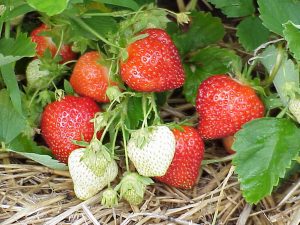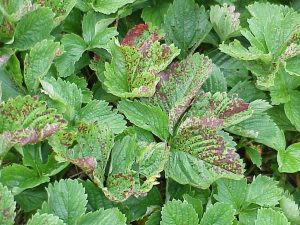Strawberry IPM Newsletter No. 3 – June 2, 2017
Strawberry IPM Newsletter No. 3 – June 2, 2017
Click on photos to enlarge.
 STRAWBERRY BLOOM TIME: MANAGE FUNGUS DISEASES
STRAWBERRY BLOOM TIME: MANAGE FUNGUS DISEASES
Scouting Report: Clipper Activity Increasing
Berry Growers Twilight Meeting
Tuesday, June 13, 2017 at 5:30 p.m.
Lavigne’s Farm in Sanford, Maine
Situation:
Many of the fields scouted this week are just in the early bloom to bloom stage, due to the continued cool, wet growing conditions. It looks as though it is going to be a late season, unless we soon see a significant change in the weather. The wet conditions should put growers on their guard for fungal diseases, including gray mold and leather rot, as these are typically more prevalent in a wet growing season.
Strawberry bud weevil or “clipper” activity has increased over the past week. Strawberry fields just coming into bloom in southern and coastal Maine were over the threshold of more than 1.2 clipped buds per 2 feet of row, and a spray was recommended. Clipper damage is likely to increase as temperatures warm and later varieties start coming into bloom. You should be scouting your fields for clipped buds now. Raspberry and blackberry growers beware; clippers will also attack the buds of these plants, although they do not appear to cause as much significant injury.
Tarnished plant bug activity continues to be very low. We have seen a few more adult bugs in the fields, but no significant nymph populations. Fields coming into bloom should be scouted regularly and often for both adults and nymphs. The control threshold for nymphs is 4 or more flower clusters infested per 30 sampled.
Two-spotted spider mite numbers remain fairly low this week, although high overwintering populations have kept some fields at risk. Extended stretches of cool, wet weather can significantly reduce mite numbers, but populations can rebound quickly when warmer, drier weather returns. Two fields we scouted this week were over threshold. The extended outlook for continued cool, weather may help to keep mites in check for the near future, but it is important to scout for them regularly.
Strawberry rootworm (not root weevil) adults and feeding injury have been found on strawberry leaves in some fields this spring. The adult stage of this insect is a small (1/8”) dark brown beetle. The beetles feed on strawberry leaves during the spring and late summer, causing numerous small holes in the leaves. The adults in fields now will soon lay eggs. The larvae are small grubs that feed on the roots of strawberry plants, causing them to be stunted and weak. If these beetles and/or feeding injury is prevalent in a field, a treatment is recommended. Sevin 50WP® is registered for control of this pest. Sprays can be timed to also control strawberry bud weevil. Strawberry rootworm should not be confused with root weevil, a larger insect that causes much more serious damage when present in a field.
Spittlebugs: The first spittlebugs of the season were found this week. The frothy spittle masses appear on the leaf stems (petioles), just below the leaflets. These typically start showing up around bloom. Although these spittlebugs don’t pose a significant threat to the plants, the frothy spittle they cover themselves with creates an annoyance for pickers. Adult spittlebugs are about ¼ inch long and bright green when they first emerge, but later turn dull yellow or brown. Spittlebugs overwinter as eggs and the nymphs emerge in late May. You should start to scout for spittlebugs when the plants are at about 10% bloom. Randomly inspect five one square foot areas per field every week. Spread the leaves and inspect the leaf bases, leaf stems, and flower stems looking for the white, frothy spittle masses. Spittlebugs tend to be a greater problem in weedy fields. Pesticides currently registered for spittlebug control include Provado®, Danitol® and Brigade®.
Diseases: Most fields have had two to three fungicide applications to protect flowers from infection with Botrytis spores, the cause of gray mold. Infections are more likely to occur under moist conditions, so it is important to keep flowers protected during the rainy stretches we’re having. Two to three fungicide sprays 7-10 days apart are usually needed to provide good protection, but additional applications may be needed when there is continued rainfall and an extended bloom, such as we are experiencing this year.
Leather rot (Phytopthora cactorum) is certainly a concern for strawberry growers this year. This disease is more common when we have long stretches of cool, wet weather during bloom and fruit development, especially when in fields where standing water is common. Foliar sprays of Aliette®, Prophyt® or Phostrol® may be applied during bloom and fruit development to prevent leather rot.

Leaf spot & leaf scorch infections have been observed in most fields this week. Leaf spot usually appears on older leaves, as small purple or red spots with white centers. Under heavy infections, a number of spots may coalesce and give the leaf a burned appearance. Leaf scorch is another foliar disease with a similar diagnosis. The spots on the leaves tend to be smaller in the case of scorch, and lack the white centers. Many spots may coalesce to turn the leaves purple and necrotic, leading to the death of the leaf and weakening of the plant. Strawberry varieties vary greatly in their susceptibility to leaf spot and leaf scorch, with many having at least some resistance. However, under high disease pressure, many will show some symptoms. Fungicides registered for leaf spots include captan, Topsin-M®, Syllit®, Cabrio®, Nova® and Pristine®.
REMINDERS:
Twilight Meeting Tuesday June 13th, Lavigne’s Strawberry Farm, 158 Whichers Mill Road, Sanford, ME 04073. Albert and Patrick Lavigne’s farm features large strawberry and high bush blueberry plantings grown on very sandy soil. They have pursued extensive pond construction and irrigation development at the site and have adapted farm equipment to better suit their crops and growing practices. We’ll have a tour of the berry fields and pond construction, and discuss the challenges of water and nutrient management in these very light soils. We will also get an update on the berry pest situation around the state, and have an opportunity to look over the equipment they use and have adapted for their operation. The meeting will run from 5:30 p.m. to 7:30 p.m. We anticipate that two pesticide applicator recertification credits will be awarded for the meeting. Hold the date!
The rusty patched bumble bee was officially listed as an endangered species under the federal Endangered Species Act on March 21, 2017. Within Maine, the US Fish & Wildlife Service (USFWS) considers the rusty patched bumble bee to occur mainly in the Stockton Springs and Rockport area. Cooperative Extension, the Wild Blueberry Commission of Maine, and USFWS are holding a meeting on Wednesday, June 21, 2017 at 6:00 pm at the Waldoboro Extension Office to discuss the listing and potential restrictions to agricultural producers in the affected areas. We will also discuss measures to promote pollinator habitat and conserve native bees. For more information contact Dave Yarborough at 800-897-0757. We hope to see you June 21st.
2017-2018 New England Small Fruit Management Guides now available. Copies can be purchased through UMaine Extension at Highmoor Farm. The guide contains the latest information on management options for small fruit pests as well as cultural information. Cost of the guide is $12.00 plus $2.63 postage for a total of $14.63. Please send checks made payable to UMaine Cooperative Extension and mail to: Highmoor Farm, P.O. Box 179, Monmouth, Maine 04259, atten. Pam St. Peter. For more information, contact Pam St. Peter at 207.933.2100 or pamela.stpeter@maine.edu.
Sincerely,
David T. Handley
Vegetable and Small Fruit Specialist
Highmoor Farm, P.O. Box 179, 52 US Route 202, Monmouth, ME 04259, 207.933.2100
UMaine Extension Diagnostic Research Lab, Pest Management Unit, 17 Godfrey Drive, Orono, ME 04473, 1.800.287.0279
Where brand names or company names are used it is for the reader’s information. No endorsement is implied nor is any discrimination intended against other products with similar ingredients. Always consult product labels for rates, application instructions and safety precautions. Users of these products assume all associated risks.
The University of Maine is an equal opportunity/affirmative action institution.
